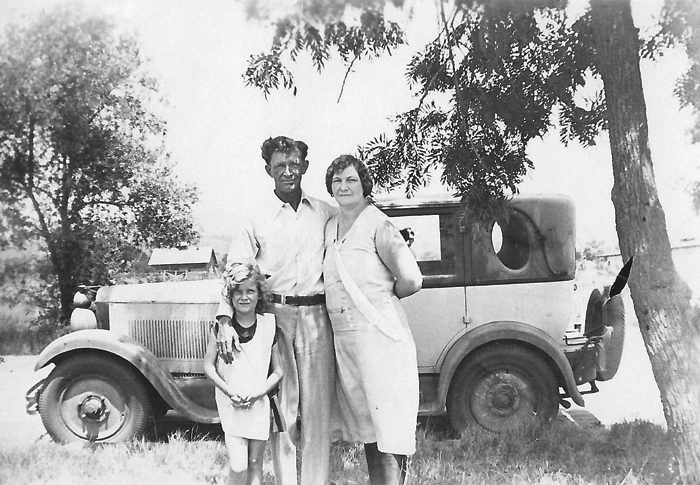|
Edgemoor, the not so poor, Farm
By Martha (Pearce) Martin
The words "poor farm," could invoke images of mistreated, destitute elderly folks but not to the residents of San Diego County's poor farm.
Situated in the sparsely settled suburb of Santee, this lovely property's proper name was Edgemoor Farm. Cooled by majestic trees and lush lawns, the residents dined on fresh vegetables, chicken, dairy products and fruit all grown on the farm by those residents who were physically able to do the work. A pig farm provided fresh meat, bacon and ham. Some of the food was sold to other agencies, thus providing a sustainable environment.
Local people volunteered to assist residents with sewing, knitting, quilting, crochet projects, the making of rag rugs and even fine arts. My mother was one of those volunteers.
We moved from East San Diego to Bostonia the spring of 1931, when my father got a job working on the State highway, the first steady job he'd had since the crash of the stock market. We rented a two bedroom $15-a-month house in the same block as Bostonia Store.

Martha, Joe, and June Pearce in Bostonia, 1931. Courtesy of Martha Martin
Since my father was now making so much money, 50¢ an hour for an eight-hour day, Mother signed me up for ballet lessons with Flora Downs School of Dance. In November that year we students performed at Edgemoor Farm for the elderly residents. I sang and danced to Alice Blue Gown, after which we were all treated to ice cream and cake. In the audience was Mrs. Lucy B. Long. She sketched while I performed and later I posed in my long blue gown while she painted my portrait. She also wrote a Christmas poem for me and decorated the page with a painting of Santa. I no longer have the portrait but the poem has survived.
Bostonia was east of Santee. At the general store one could run a tab to purchase groceries, borrow a library book, gossip at the post office, buy clothing and shoes, have the proprietor scoop staples from bins of sugar, flour, beans and rice, and I could ponder over the choice of penny candy. It was a meeting place for out of work men, overseen by a huge gray cat that slept on a great round of cheese atop a barrel. Store owners were Murray and Bea Wright, generous people known to throw great costume parties in their home, the former livery. Guests brought their own home brew.
Saint John's Episcopal Church was behind our house, and a block away the opposite direction we could see Hamilton Judy's Ballroom. Jack Shrade (later State Senator) lived near the ballroom.
One form of entertainment at Edgemoor Farm was provided by Hollywood actors who journeyed south on long weekends to stay at the nearby ranch of Alan Le May, a writer of adventure novels and western films, some of which starred Errol Flynn. These visitors clamped their knees to high strung polo ponies, trying to master the game of polo as they played on Edgemoor's very own polo field. Occasionally Mr. Le May allowed older children to try their hand at polo to entertain his Hollywood guests. At ten I became one of those children who rode horses from home, some of which were animals our families used for plowing. We'd borrow our mothers' brooms for polo mallets and en route to Santee, raid the local orchards for hard green grapefruit to use as balls.
I remember the sound of laughter as we urged our plodding plow horses towards the goal, then riding home and handing Mother her broom with only the handle remaining.
About the Author Originally from the Bostonia neighborhood of El Cajon, author Martha Martin attended the Institute of Children's Literature and is a member of the Whidbey Island Writers Association. She has written articles for numerous publications such as The Doll reader, Teddy Bears and Friends, and Doll News, and is the author of several children's books, including Chipper, The Heroic Chipmunk and How Bonnie Got Her Tutu.
This story of depression era San Diego came to us because the author found the article about Edgemoor from Our Heritage, Volume 34, Issue 3/4 online and thought we might like to know more about this historic site and the place it held for the community.
|
MORE FROM THIS ISSUE
From the Editor
2009 People In Preservation Award Winners
Historic Preservation & Environmental Conservation
The Green Game
Making your historic home more energy efficient
Your home's landscape is green in more ways than one
San Diego Trust & Savings Bank Building
Black Gold in San Diego
2009 Most Endangered List of Historic Resources
Tragedy Unfolds
Preservation Community
Reflections
Recognition
The Whaley House Porch Returns
Museum News: Marston House
Borrego Springs Modern lll
Borrego's future lies in its past
Adobe University
An Enchanted Evening at PIP
Looking for historic homes, gardens or commercial sites
Help Us
Lost San Diego
Strength in Numbers
Advertisements
DOWNLOAD full magazine as pdf (9.7mb)
|




